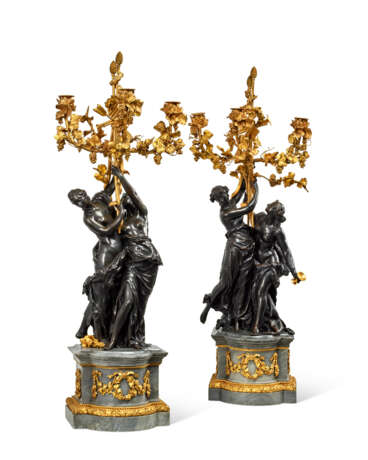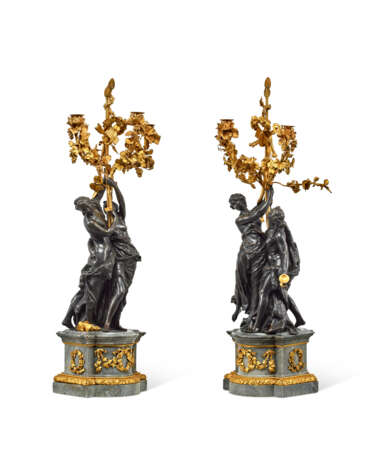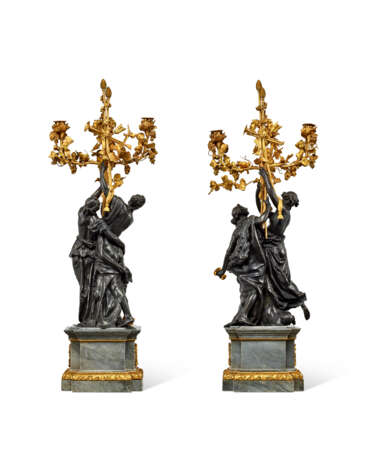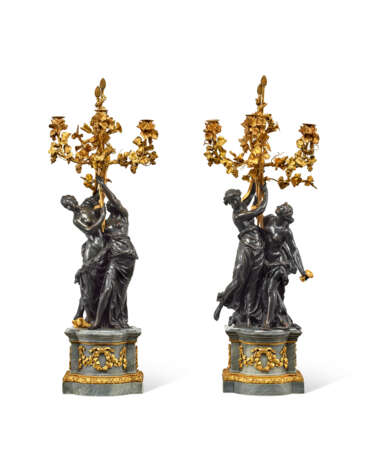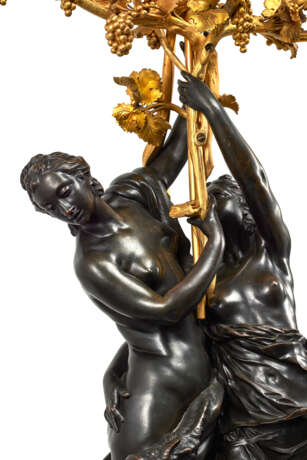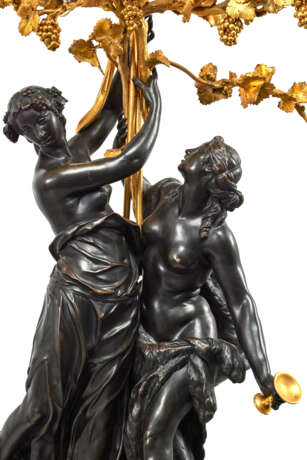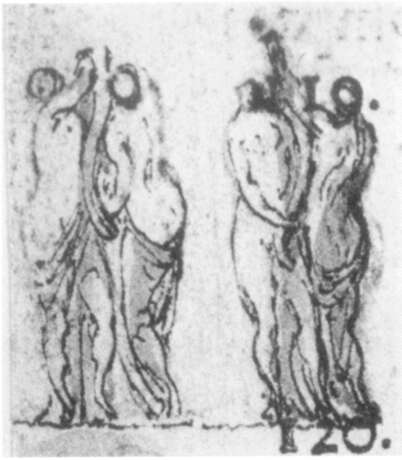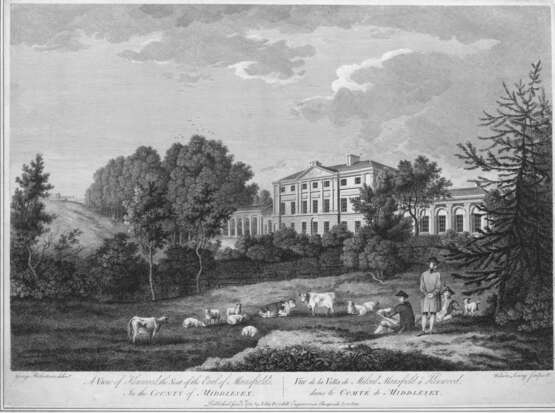ID 1329901
Лот 32 | PAIRE DE CANDÉLABRES D'ÉPOQUE LOUIS XVI
Оценочная стоимость
€ 80 000 – 120 000
DERNIER QUART DU XVIIIE SIÈCLE
En bronze patiné et bronze ciselé et redoré, marbre bleu turquin, à trois lumières en branches de pampres de vigne soutenues par deux bacchantes, sur une base ornée de guirlandes de lierres enrubannées et soulignée d'un perlé
H. 106 cm. (47 ¾ in.) ; L. 36 cm. (14 ¼ in.) ; P. 27 cm. (10 ½ in.)
Provenance
Probablement achetée à Dominique Daguerre par David Murray, 2nd comte de Mansfield et 7ème vicomte Stormont (1727-1796), pour Kenwood House, Londres.
Transférée à Scone Palace avant 1922;
Puis par descendance au 8ème comte de Mansfield;
Vente Christie's, Londres, 24 mai 2007, lot 268.
Galerie J. Kugel, Paris.
Literature
Bibliographie comparative:
H. Ottomeyer et P. Pröschel, Vergoldete Bronzen, vol. I Munich, 1986, p. 254.
Further details
A PAIR OF LOUIS XVI PATINATED AND GILT BRONZE THREE-LIGHT CANDELABRAS, LAST QUARTER 18TH CENTURY
This elegant pair of candelabras is typical of the neoclassical taste that prevailed at the end of the 18th century, celebrating antiquity and mythological motifs.
Their refinement and quality of execution bear witness to remarkable craftsmanship.
Each piece is finely crafted in patinated and gilded bronze, representing two female figures in a graceful posture, supporting a group of flowering branches. Inspired by mythology and neoclassical aesthetics, their antique-style drapery and expressive, dynamic posture lend a real sense of movement to the whole. The richly ornate gilded branches add a luminous touch, contrasting magnificently with the dark bronze of the figures. The turquoise marble bases give visual and physical stability to these sumptuous pieces.
A prestigious provenance
This pair of candelabra would almost certainly have formed part of the collection of David Murray, 2nd Earl of Mansfield, 7th Viscount Stormont (1727-1796) at Kenwood House in London, as attested by an inventory drawn up by C.B. King on 19 February 1910, vol. 1, p. 30, item 260 which mentions: a pair of Empire candelabra with two bronze female figures supporting a three-light gilt bronze branch... on a chased gilt bronze and marble base - size 3ft. 1 (the difference of 5 inches with our present lot could be explained by the fact that the measurement is that taken from the height of the outer branches). Located in North London, Kenwood House is famous for its elegant architecture and rich artistic heritage. The 2nd Earl of Mansfield, a great lover of art and an aesthete, continued to embellish this emblematic Georgian residence by adding pieces of the highest quality, including our candelabras, which perfectly reflect the neoclassical aesthetic favored by the British nobility of the time. This style, marked by an admiration for Greco-Roman antiquity, was ideally suited to the architecture of Kenwood House, which had been magnificently renovated by the architect Robert Adam a few decades earlier. The pair of candelabras was later moved to Scone Palace, where Scottish kings were crowned for almost 1,000 years.
A collaboration of craftsmen
This model could well be the result of a collaboration between several craftsmen under the direction of Dominique Daguerre. A renowned marchand-mercier, he was active both in Paris and London at the end of the 18th century. He first set up shop on rue Saint Honoré. As his label reveals, he kept a shop selling porcelain, bronze, cabinetwork, mirrors, curiosities and other goods. In 1786 he signed an agreement with Josiah Wedgwood for the exclusive rights to sell Wedgwood porcelain in Paris. In the 1780s, he opened a shop in Piccadilly, London, to supply George, Prince of Wales, and his entourage, including the Duke of Bedford, Earl Spencer and most likely David Murray 2nd Earl of Mansfield. His commission of these candelabra shows his desire to follow the artistic trends of his time.
The nymph figures here appear to have been inspired by, though not directly copied from, a group of plaster nymphs by Etienne-Maurice Falconet, exhibited at the Salon of 1761 and illustrated by Gabriel de Saint-Aubin in the exhibition catalogue. The French philosopher Denis Diderot even described these figures as simple, noble and antique in character. Although the composition of the present lot differs from Falconet's prototype, it is the attention to detail and the treatment of the female form, as well as the complexity of the composition, that make this model so interesting. Every gesture, every outstretched hand and foot draws the eye upwards, from the feet to the fingertips. Even the softness of the nude figures contrasts in a subtle and sophisticated way with the textured surface of the skins.
Daguerre is also known to have supplied candelabra of similar design with bronze putti after Falconet, mounted on similar plinths, both to George, Prince of Wales, future King George IV for Carlton House (illustrated in situ in the White Drawing Room in J. Harris et al, Buckingham Palace and its Treasures, New York, 1968, p. 59) and to his entourage - including the Earl of Harewood and the Earl of Bradford. He also sold a pair at Christie's London sale on 25 March 1791, lot 53 (P. Hughes, The Wallace Collection, Catalogue of Furniture, London, 1996, Vol. III, no.251, F140-141). We also know of a pair of torches after Falconet that uses these female figures and the distinctive vine shoot decoration, now in the Musée des Arts Décoratifs in Paris (Inv. 32633).
| Адрес торгов |
CHRISTIE'S 9 Avenue Matignon 75008 Paris Франция | ||||||||||||||
|---|---|---|---|---|---|---|---|---|---|---|---|---|---|---|---|
| Предосмотр |
| ||||||||||||||
| Телефон | +33 (0)1 40 76 85 85 | ||||||||||||||
| Факс | +33 (0)1 40 76 85 86 | ||||||||||||||
| Условия использования | Условия использования | ||||||||||||||
| Транспортировка |
Почтовая служба Курьерская служба Самовывоз | ||||||||||||||
| Способы оплаты |
Банковский перевод | ||||||||||||||
| Часы работы | Часы работы
|
